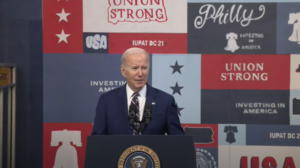The White House’s fiscal year 2024 budget request released Thursday calls for $886 billion in defense spending, to include boosting the Pentagon’s topline by 3.2 percent up to $842 billion.
The spending plan drew support from leading Democratic lawmakers, while Republicans have already pushed back on the budget request for increasing non-defense spending at a greater percentage than defense.

“The budget continues to ensure that U.S. soldiers, Sailors, Airmen, Marines, and Guardians remain the best trained and equipped fighting forces in the world. The budget places additional emphasis on foundational investments to sustain current weapon systems and support increased training across the [Defense] Department, while pursuing technological enhancements to extend the service life of materiel vital to the warfighter,” Biden said of his FY ‘24 budget request. “The budget supports DoD’s plan to upgrade capabilities by redirecting resources to cutting-edge technologies in high priority platforms.”
Thursday’s budget release focused mainly on high-level funding plans, while the Pentagon is set to provide details on specific programs and line items on March 13.
“With this strong budget, President Biden is prioritizing the safety and well-being of the American people. Some will inevitably say the topline is too much, while others will claim it is not enough. I say America’s defense budget should be guided by our values, needs, and national security strategy,” Sen. Jack Reed (D-R.I.), chair of the Senate Armed Services Committee (SASC), said in a statement. “This topline request serves as a useful starting point. I look forward to receiving the detailed budget request so we can get to work crafting a responsible, balanced National Defense Authorization Act.”
Sen. Roger Wicker (R-Miss.), the top Republican on SASC, however, called the defense budget request “woefully inadequate and disappointing.”
“It does not even resource his own National Defense Strategy to protect our country from growing threats around the world. This defense budget is a serious indication of President Biden’s failure to prioritize national security,” Wicker said.
Rep. Mike Rogers (R-Ala.), chair of the House Armed Services Committee, also previewed the budget debates ahead as Republicans will look to push for an increased topline above the requested level.
“Unfortunately, the president has once again submitted a budget request that fails to take these threats seriously. A budget that proposes to increase non-defense spending at more than twice the rate of defense is absurd. The president’s incredibly misplaced priorities send all the wrong messages to our adversaries,” Rogers said. “As we examine the president’s budget and build the FY ‘24 NDAA, we will continue to engage with DoD officials to determine what weapons, resources, and authorities our warfighters need to defeat the threats we face. Our adversaries will only be deterred by strength, not weakness.”
The budget request overview first highlights $6 billion in investments “to support Ukraine, the United States’ strong alliance with the North Atlantic Treaty Organization (NATO), and other European partner states by prioritizing funding to enhance the capabilities and readiness of United States, allied, and partner forces in the face of continued Russian aggression.”
The spending plan also aligns with the National Defense Strategy’s emphasis on China as “America’s pacing challenge,” according to the White House, to include $400 million for a “Countering [People’s Republic of China] Influence Fund” aimed at strategic competition efforts.
The Pentagon’s Pacific Deterrence Initiative would also receive $9.1 billion with investments focused on “strengthening deterrence in the region, and [demonstrating] the department’s long-term commitment to the Indo-Pacific.”
“DoD is building the concepts, capabilities, and posture necessary to meet these challenges, working to integrate deterrence efforts across the United States government and with U.S. allies and partners,” the White House wrote in the budget plan.
While the budget request released publicly on Thursday lacks specific program details, the White House did provide insight into broad investment priorities for the Pentagon.
For nuclear weapon capabilities, the budget includes $37.7 billion and supports “ongoing nuclear modernization programs, to include the nuclear command, control, and communication networks.”
The White House’s request also funds the Air Force’s procurement of “a mix of highly capable crewed aircraft while continuing to modernize fielded fighter, bomber, mobility, and training aircraft.”
“The budget also accelerates the development and procurement of uncrewed combat aircraft and the relevant autonomy to augment crewed aircraft. Investing in this mix of aircraft provides an opportunity to increase the resiliency and flexibility of the fleet to meet future threats, while reducing operating costs,” the White House wrote.
Air Force Secretary Frank Kendall told reporters on March 7 the service’s FY ‘24 budget request is expected to fund about a dozen new start programs that will require congressional authorization, to include the Next-Generation Air-Refueling (NGAS) tanker and a buy of perhaps 1,000 Collaborative Combat Aircraft (CCAs) to be employed by 200 Next Generation Air Dominance (NGAD) manned fighters and 300 Lockheed Martin [LMT] F-35As (Defense Daily, March 7).
The budget request also continues the Navy’s recapitalization of the “strategic ballistic missile submarine fleet while investing in the submarine industrial base,” according to the White House.
“Maintaining U.S. naval power is critical to reassuring allies and deterring potential adversaries. The budget proposes executable and responsible investments in the U.S. Navy fleet,” the White House wrote. “In addition, the budget makes meaningful investments in improving the lethality and survivability of the fleet, particularly improving undersea superiority.”
For the Army, the White House noted the budget continues investment in the service’s new Multi-Domain Task Forces, which features non-kinetic and long-range strike capabilities, as well as pushes efforts to expand production capacity of critical munitions.
Doug Bush, the Army’s top acquisition official, said on Monday the service’s FY ‘24 budget request keeps its “modernization plan on track” (Defense Daily, March 6).